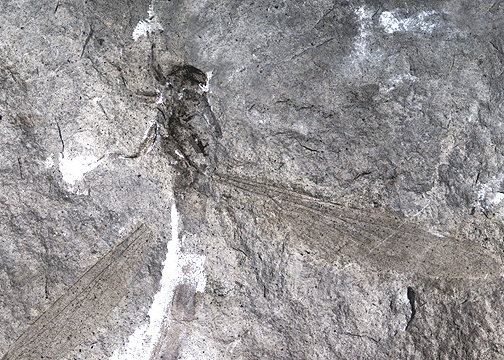Abstract
The small Paleozoic protozygopteran family Permagrionidae comprises 11 described species in 5 genera from the Lower Permian Chekarda and Solikamsk localities in Russia (Zalessky, 1948; Nel et al., 2012) and Salagou Formation in France (Nel et al., 1999; Fate et al., 2013), the Middle Permian Soyana and Kargala localities in Russia (Martynov, 1932; Martynov, 1937; Nel et al., 2012), and the Upper Permian Bodie Creek Head locality in Malvinas Tillyard (1928). Here we describe the new species, Epilestes rasnitsyni sp. nov. from the Ufimian of Perm Territory, which is characterized by specific arrangement of veins in the petiole and the unique preservation of body structures.
References
Bechly, G. (1996) Morphologische Untersuchungen am Flügelgeäder der rezenten Libellen und deren Stammgruppenvertreter (Insecta; Pterygota; Odonata), unter besonderer Berücksichtigung der Phylogenetischen Systematik und des Grundplanes der Odonata. Petalura, 2, 1–402.
Bechly, G. (2008) Phylogenetic systematics of Odonata. Available from: https://bechly.lima-city.de/phylosys.htm (accessed 28 April 2021).
van Dijk, D.E. & Geertsema, H. (1999) Permian insects from the Beaufort Group of Natal, South Africa. Annals of the Natal Museum, 40, 137–171. https://hdl.handle.net/10520/AJA03040798_102
Martynov, A. (1932) New Permian Paleoptera with the discussion of some problems of their evolution. Trudy Paleontologicheskogo Instituta Akademii Nauk SSSR, 1, 1–44 [In English, with Russian summary].
Martynov, A. (1937) Permian fossil insects from Kargala and their relationships. Trudy Paleontologicheskogo Instituta Akademii Nauk SSSR, Moscow–Leningrad, 7, 8–92 [In Russian].
Needham, J.G. & Anthony, M.H. (1903) The skewness of the thorax in the Odonata. Journal of the New York Entomological Society, (3) 11, 117–125. https://www.jstor.org/stable/25003040
Nel, A., Martínez-Delclòs, X., Paicheler, J.C. & Henrotay, M. (1993) Les ‘Anisozygoptera’ fossiles. Phylogénie et classification (Odonata). Martinia, Numéro Hors Série 3, 1–311.
Nel, A., Gand, G., Garric, J. & Lapeyrie, J. (1999) The first recorded protozygopteran insects from the Upper Permian of France. Palaeontology, 42, 83–97. https://doi.org/10.1111/1475-4983.00063
Nel, A., Bechly, G., Prokop, J., Béthoux, O. & Fleck, G. (2012) Systematics and evolution of Paleozoic and Mesozoic damselfly-like Odonatoptera of the ‘Protozygopteran’ grade. Journal of Paleontology, 86, 81–104. https://doi.org/10.1666/11-020.1
Riek, E.F. & Kukalová-Peck, J. (1984) A new interpretation of dragonfly wing venation based upon early Upper Carboniferous fossils from Argentina (Insecta: Odonatoidea) and basic character states in pterygote wings. Canadian Journal of Zoology, 62, 1150–1166. https://doi.org/10.1139/z84-166
Tillyard, R.J. (1928) A Permian fossil damselfly wing from the Falkland Islands. Transactions of the Entomological Society of London, 76, 55–63. https://doi.org/10.1111/j.1365-2311.1928.tb01187.x
Zalessky, G.M. (1948) Nasekomye iz permskih otlozheniï Solikamskogo i Cherdynskogo raïonov. Voprosy Teoreticheskoï i Prikladnoï Geologii, 5, 44–52.


